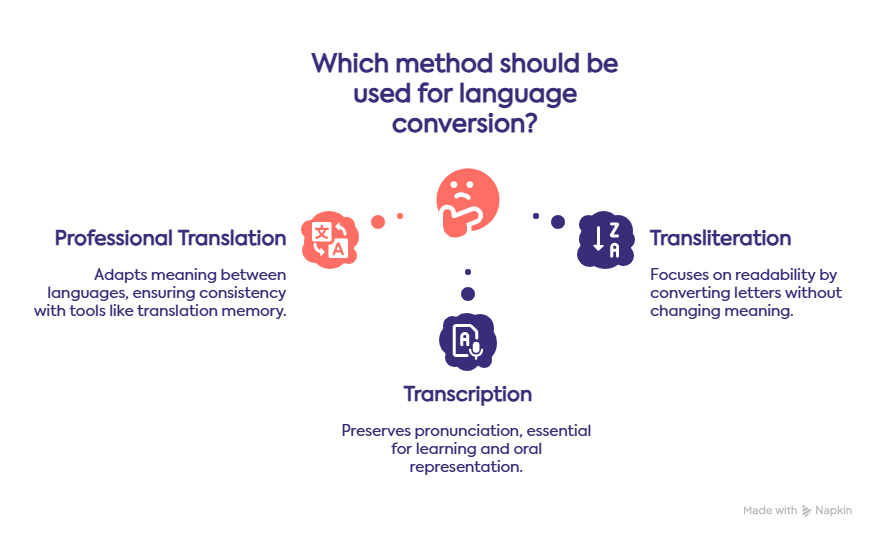Transcription vs. transliteration – what’s the difference? How to work on transcription conveniently?

In the realm of languages, understanding the difference between transcription and transliteration is essential. Although both processes involve the conversion of text, they serve distinct purposes and follow different methodologies. This article focuses on explaining the transcription vs transliteration concepts and provides tips on how to work conveniently with transcription.
We will help you communicate with anyone, at any time, wherever they are. In all languages.
Transcription vs transliteration – understanding the differences
Transcription is the process of converting spoken language into written language. It focuses on preserving the pronunciation of speech, often using phonetic systems such as IPA (International Phonetic Alphabet) to capture the exact sounds. Transcription is particularly useful in linguistics, media production, and language learning where the accurate representation of speech is necessary.
Transliteration, on the other hand, refers to the process of converting text from one writing system to another, preserving the original characters’ approximate pronunciation by substituting them with letters from a different alphabet or script. Unlike translation, which conveys meaning, transliteration preserves the way words are pronounced without changing their meaning.
Key differences: transcription vs transliteration
| Process | Input | Focus | Example |
|---|---|---|---|
| Transcription | Spoken language (audio) | Pronunciation and phonetics | Converting audio speech to text |
| Transliteration | Written text in one script | Conversion from one script to another | Writing “Москва” as “Moskva” |

How to work on transcription conveniently?
Transcription can be time-consuming but can be made easier with the right tools. Some effective ways to transcribe audio include:
- Using voice typing tools such as Google Docs Voice Typing, which converts spoken language into text in real time.
- Utilizing software like Descript that offers AI-powered transcription, speaker identification, and editing features.
These tools simplify the process of converting spoken language into written text, increasing productivity and accuracy.
Transcription vs transliteration – practical applications
Understanding the differences between transcription and transliteration helps choose the right approach for different tasks:
- For converting speech to written text, especially when capturing exact pronunciation, use transcription.
- For converting text from one writing system to another, especially for names or technical terms, use transliteration.
While both methods deal with converting text or speech, their purposes and outcomes are fundamentally different.
Transliteration and transcription in different writing systems
Transliteration plays a crucial role when dealing with languages that use a different script or non-Latin alphabet, such as Cyrillic script, Arabic, or Chinese characters. The process of converting text from one script to another helps make content accessible to readers unfamiliar with the original writing system.
Conversely, transcription focuses on converting spoken sounds or phonemes into a written form that represents pronunciation accurately, regardless of the original script. This is especially important in fields like phonetics and language teaching, where capturing the exact way words are spoken is necessary.
For example, the Russian city name “Москва” is:
- Transliterated as “Moskva” (changing from Cyrillic to Latin script),
- But transcribed phonetically as [mɐˈskva], capturing how it sounds.
Both processes play crucial roles in linguistics and communication but serve different purposes.
Why understanding the differences matters for effective communication
A clear understanding of transcription vs transliteration is vital for translators, linguists, and anyone working with multilingual content. Choosing the wrong method can lead to confusion or miscommunication.
- Professional translation involves adapting meaning from one language to another, often using tools like translation memory or machine translation to maintain consistency.
- Transliteration usually focuses on readability by converting letters from one writing system to another without changing meaning.
- Transcription is useful when the goal is to preserve pronunciation, which is key for learning and accurate oral representation.

Understanding these differences ensures that text or speech is accurately converted for its intended purpose, whether it’s for subtitles, international documents, or linguistic research.
Other articles:
Audiovisual translation – what is it?
Food product labels and national requirements
Translating text from an image
We will help you communicate with anyone, at any time, wherever they are. In all languages.
Marketing translation as the key to success of the fashion industry. Cooperation with a popular fashion brand
We cooperated with many customers on a daily basis. They include local companies, international enterprises and well-known brands. What are the similarities between all of them? Everyone expects high-quality translations that will help in business development. Additionally, professional translations affect their image, contribute to the opinions of recipients and are the decisive factor when it […]
Hemingway Editor and other tools for text proofing and translation
Typically, content writers first note down the message they wish to put across to their audience. Then, they re-read and edit the text. This way, they can achieve better readability, understanding and structure, and at the same time they can correct any errors in the content. It is a complex process, but fortunately there are […]
Translation of advertising slogans – how not to fall into the language trap?
Advertising translation involves the process of transferring advertising messages from one market to another. The advertising discourse is created in a language that is not only a communication tool, but also an expression of culture. This makes ad translation a highly accuracy-demanding activity. Translating slogans requires both a cultural and linguistic connection. Adapting a brand […]
Top 8 Languages for E-commerce purposes: Boosting Global Reach Through Effective Translation
Do you manage an e-shop and want to source customers abroad to increase profit? Translation will be the basis for reaching foreign recipients with your offer. You need to start speaking their local language and adjust product descriptions or service descriptions to the country where you intend to sell them. This process of adapting your […]



